*01/08/23 - This article originally appeared on My Fishing Cape Cod in 2013. I am currently updating this article for the 2023 Cape Cod tuna fishing season. As you read this article, please keep in mind the content is not yet completely with new information, links, videos and photos. Please check back later this month when the full update will be complete.
My fascination with bluefin tuna began when I was a kid fishing with my dad from our 12 foot boat, only about 300 yards off the beach shown in the map below. It was a flat calm, sweltering mid-August morning.
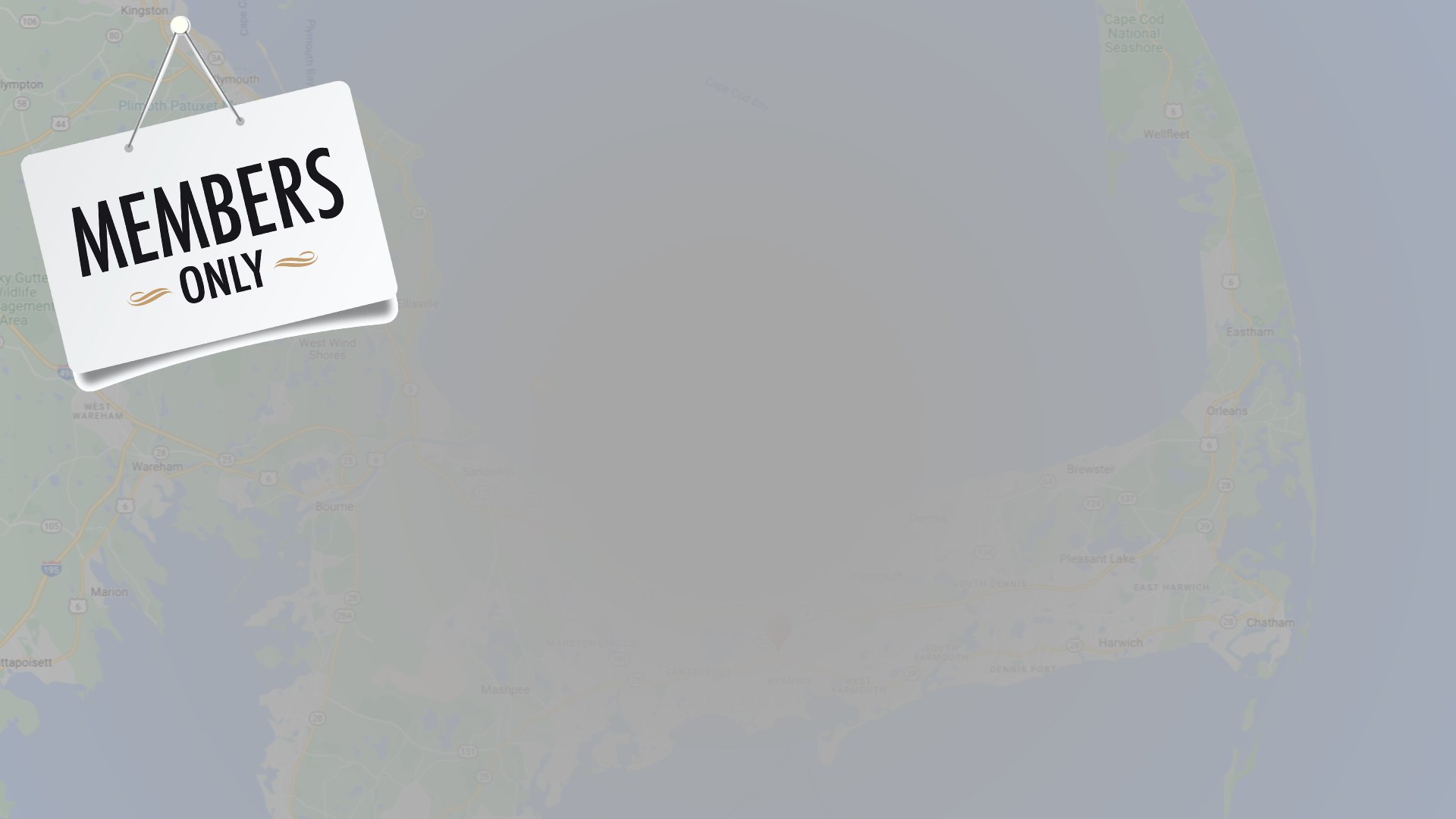
The fact I had two more weeks of summer vacation, and a hefty bluefish on my line had me feeling ecstatic. But as I eased the toothy critter towards our small aluminum boat, I got a glimpse of a fish that would change my future forever.
In the crystal clear water behind and slightly below the feisty bluefish was a behemoth of a tuna, a true brute that looked to be at least have as long as our boat. With my heart in my throat I released the bail on my reel and let the nearly boat-side bluefish swim freely, praying that the tuna would engulf the hapless creature.

On Cape Cod bluefin tuna sometimes come amazingly close to shore. This is the little boat from which my dad and I had our first tuna encounter.
However I was too late-hundreds of pounds of powerful sashimi had disappeared. Honestly I was better off, considering there was no chance I would be able to land that tuna using my light tackle schoolie striper outfit.
Since that day I've been fascinated with tuna, and fortunately over the past 15 years I've had many memorable tuna fishing experiences. In this post I'd like to provide an overview of Cape Cod tuna fishing, as well as share some of the lessons and tips I've learned over the years.
You can continue reading my scrolling below, or jump to a specific part of the article by clicking an item on this table of contents.
Close-to-Shore Bluefin Tuna Fishing
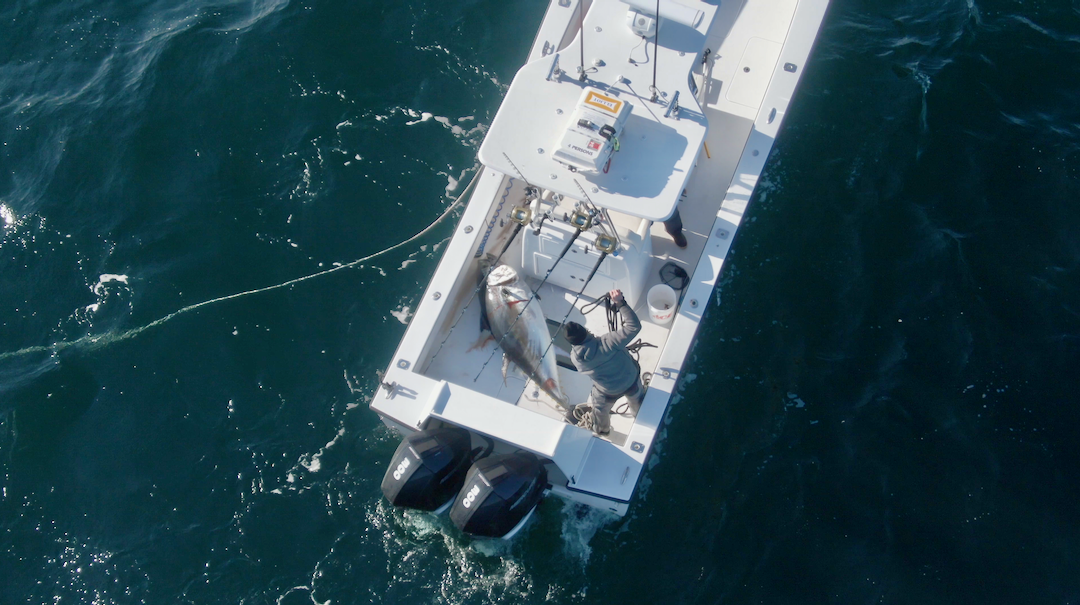
The author assisted in catching this 91 inch giant bluefin tuna during early December 2022 while fishing with Cullen Lundholm, a local commercial tuna fishermen. The fish was taken within sight of the beach.
The beauty of tuna fishing off Cape Cod is that it's possible to find and catch tuna while staying in sight of the shoreline. This is good news for anglers with a small boat more apt for inshore fishing.
In fact, over the past decade anglers off Cape Cod have even managed to catch bluefin tuna from kayaks.
My first encounter with blitzing schools of bluefins within sight of the beach happened during June of 2010. School sized bluefin tuna had infiltrated the waters just a few miles north of the popular and beautiful Cape Cod harbor shown in the map below.

During June of 2010 a small group of anglers who bypassed the longer steam to Stellwagen Bank played witness to pods of surface feeding tuna that were slashing and molesting vast numbers of tinker mackerel and other baitfish that had taken up residence in Cape Cod Bay.
For my 21 foot boat, the ride to Stellwagen Bank and other popular tuna fishing locations can only be done safely on the calmest of days. Having bluefin this close to shore opens up a whole new world for anglers like me who usually fish from smaller vessels.
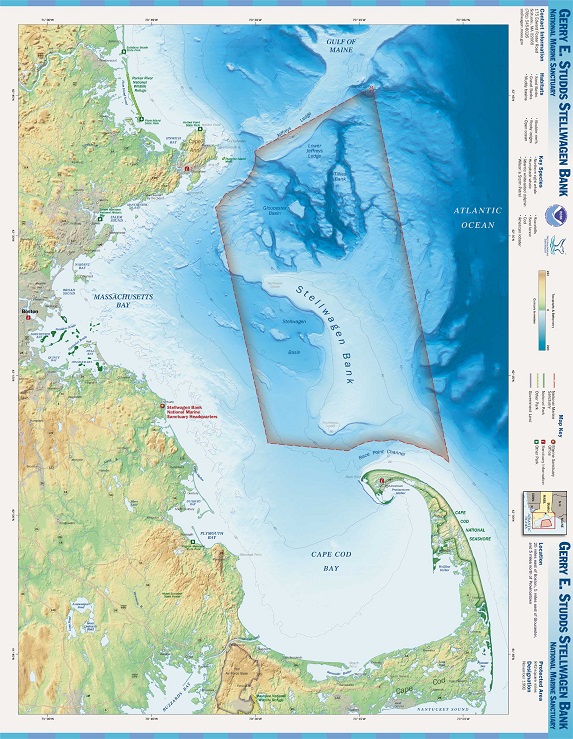
Stellwagen Bank National Marine Sanctuary is a hot spot for school and giant bluefin tuna. Compared to other tuna fishing spots around the world, the bank is not at all far from shore. However, on Cape Cod tuna will come even closer to shore than Stellwagen, with bluefin sometimes feeding less than a mile from the beach.
When I was in my mid-twenties I got a call from my Cape Cod tuna fishing buddy Jason Mazzola that I've never forgotten. It went something like this.
Mazzola: "Hey I was just down at the beach and saw tuna busting about 500 yards from shore."
Me: "Huh?"
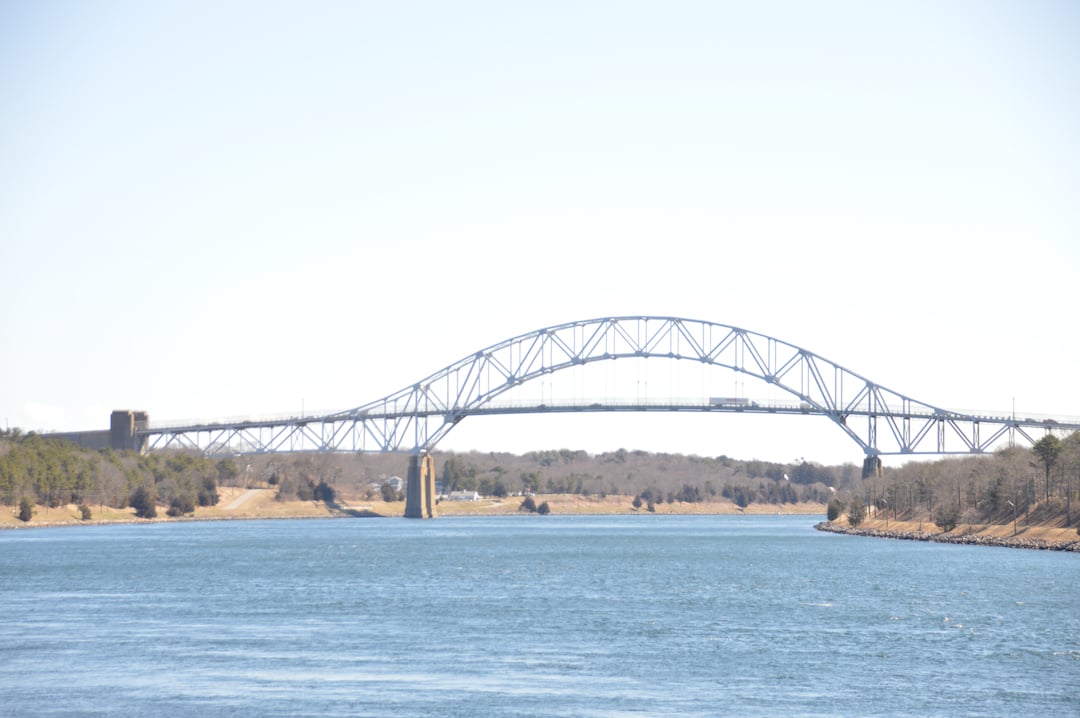
Each year there are reports of bluefin tuna being spotted inside the Cape Cod Canal. Some anglers even say they have hooked tuna in the canal. Typically the sightings occur during September, October or November. A majority of the sightings are more than likely breaching ocean sunfish (mola mola). Nevertheless some of the sightings are actually tuna, both school and giant size.
To be honest, I thought for a moment that my friend might be losing his marbles. Could he really be seeing tuna?
I think most people would have the same reaction. Cape Cod bluefin tuna are most often caught miles from shore. These insane fish are capable of swimming across the Atlantic Ocean, and back in just a few months. How in the world could they be pushing bait within swimming distance from shore?
The fact of the matter is that many close to shore tuna sightings are actually ocean sunfish, or mola-molas if you want to be scientific. Ocean sunfish are enormous, awkward looking fish, capable of launching themselves straight clear of the water. This creates quite the splash, which people often mistake for tuna.
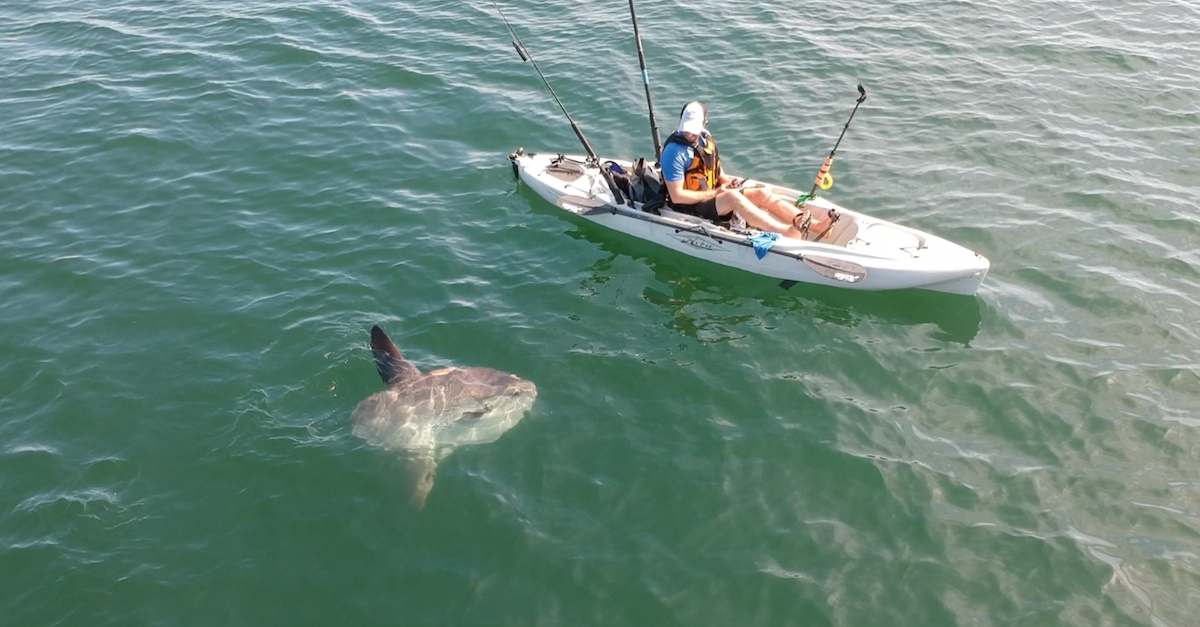
Ocean sunfish are enormous, awkward looking fish, capable of launching themselves straight clear of the water. This creates quite the splash, which people often mistake for tuna. I encountered this juvenile ocean sunfish while kayaking off Plymouth in August of 2020.
Yet my friend Mazzola knows the difference between a tuna and a sunfish.
After a similar call the next day, I hopped in my car and drove to the beach parking lot below, which overlooks Cape Cod Bay.

The sky was cloudy and the breeze was cranking around 30 knots. I looked out towards the bay and if on cue, a chunky 150 pound class bluefin tuna propelled itself 6 feet clear of the water. The fish hung in the air for a moment before slicing its way back into the water.
The fish was not alone either. Roughly 500 yards from shore, no more than a half mile down the beach, tuna were taking turns launching themselves into the air. Some of the fish jumped so high that I almost lost sight of them in the overcast and misty conditions.
"They must be feeding on half beaks" I remember thinking to myself. We had seen tuna behave like this before when feeding on half beaks at Stellwagen Bank.

Halfbeaks are a baitfish similar to ballyhoo. They typically show up off Cape Cod during the fall and are a favorite prey item for bluefin tuna. When tuna are feeding on halfbeaks they will sometimes come amazingly close to shore. The tuna will also go completely airborne as they hunt halfbeaks, which makes for some very exciting fishing.
I was in awe, and Mazzola was spot on.
For three days the tuna fed less than one half of a mile from the beach. Afternoon seemed to be the best time to look for them, with early morning a close second.
I will be the first to admit that a scene like this is not common on Cape Cod. However if you spend enough time at a local bait shop, you will begin hearing stories. Each fall at least a few bluefin tuna venture into the Cape Cod Canal, while other fish have in the past cornered menhaden within Plymouth Bay and Provincetown Harbor.
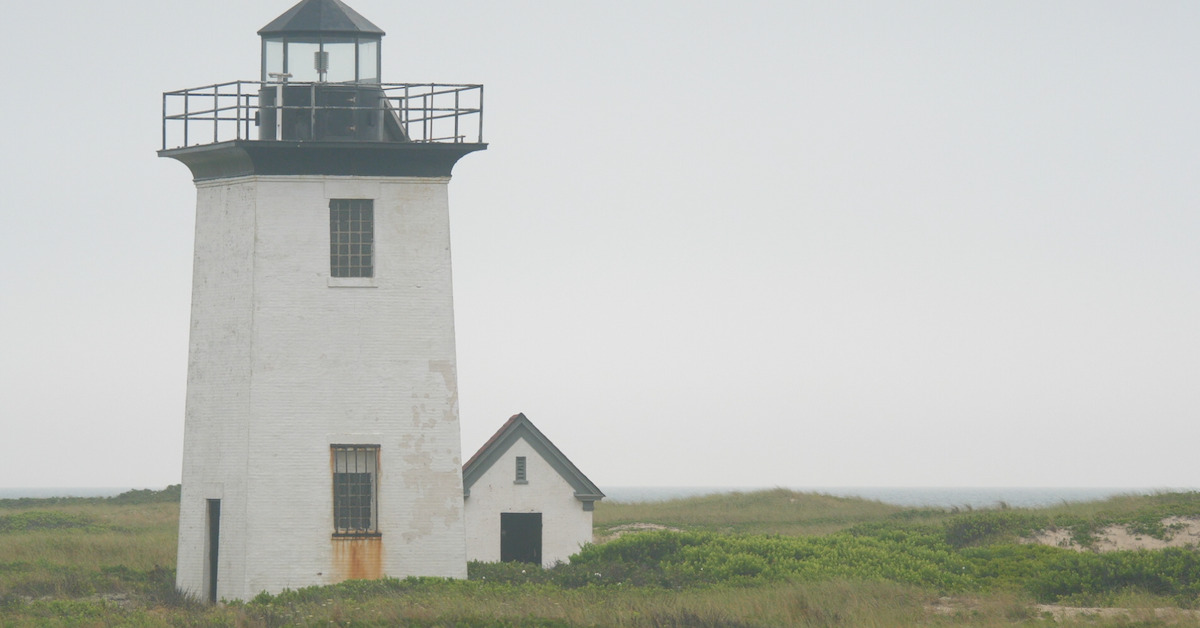
The bottom off Wood End Lighthouse at Provincetown drops off quickly to more than 100 feet deep. This makes Provincetown a good place to find bluefin tuna close to shore. In fact, back in the 1950's and 1960's, surfcasters fishing from this area of the Cape actually landed small bluefin tuna while fishing from the beach.
Tuna will also come very close to shore along the back beaches of Cape Cod, which is the stretch of shoreline from Chatham in the south to Provincetown in the north. There have even been confirmed catches of bluefin tuna caught by surfcasters off Race Point beach back in the 1950's and 1960's.
Your chances of hooking a tuna this season will definitely improve if you venture to more offshore locations (which we'll talk more about below). Nevertheless, always keep your eyes open, and don't think you have to travel dozens of miles offshore to hook a fish. Some of the best tuna fishing grounds are right in our backyard.
Catching Your First Bluefin Tuna
There is nothing quite like the expression on the face of a virgin tuna angler when they finally hook up with a Bluefin. It is usually a mix of shock, awe and fear.
Ask any fisherman who has successfully landed a tuna and they will vouch for its fighting power and unyielding endurance. The fight is commonly compared to reeling in a Volkswagen beetle or a small truck.
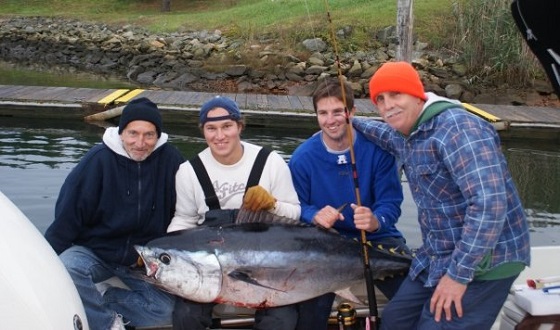
This was the first tuna I ever caught, and I was lucky to do it while fishing with one of my best friends and our dads. It was definitely an experience I will never forget! We caught the fish near the Southwest Corner of Stellwagen Bank by trolling a large Hogy soft plastic across the surface.
But catching a tuna can be done, and a large boat and fancy equipment is not always necessary. The key ingredients for breaking the ice in the tuna world are a boat, a safety conscious captain, and a burning desire to catch a tuna.
Hooking up with that first tuna is an experience that will never be forgotten. However it can take a toll on a fisherman's body. Even small tuna have a reputation as being one of the hardest fighting fish in the ocean.
For example, according to my friend David D'Amore, "My first experience fighting a tuna was similar to that of upgrading from a Honda Civic to a Ferrarri. I would struggle for an hour to recover several yards of line, only to have fifty yards taken back in an instant."
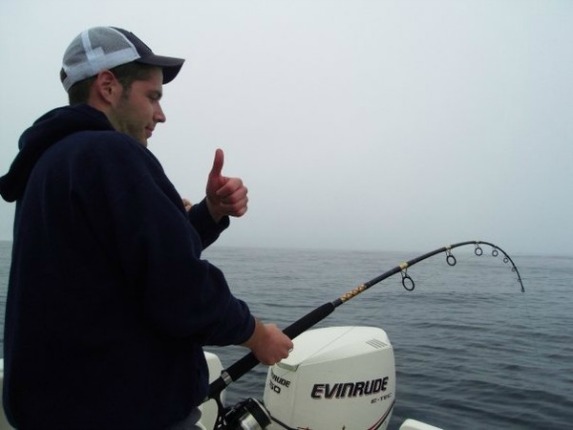
My college buddy Chris Bird fighting his first ever bluefin tuna. Catching a tuna using spinning tackle can be quite taxing on the body. I'm personally not much of a fan of catching tuna larger than 150 pounds on spinning gear - it's just too much work!
My good college buddy Chris Bird had a similar experience. "I came into it feeling 10 feet tall and as strong as an ox, and left completely beat up. The fish dominated me."
So if an angler already possesses the key ingredients of a boat, a safety conscious captain and a burning desire to catch a tuna, where is the best place to start?
Tuna Fishing Permits
Unfortunately things can get confusing. There are almost as many ways to catch a tuna as there are tuna swimming in the ocean. The most important thing is to find a technique suitable to your means. For the sake of this article, we will focus on bagging a tuna from a small boat (around 20 feet in length).
The first decision to make is what size of tuna to pursue. Unfortunately, targeting giant tuna will require a general category or charter/headboat permit, a life raft, an EPIRB and survival suits-which is extremely costly.
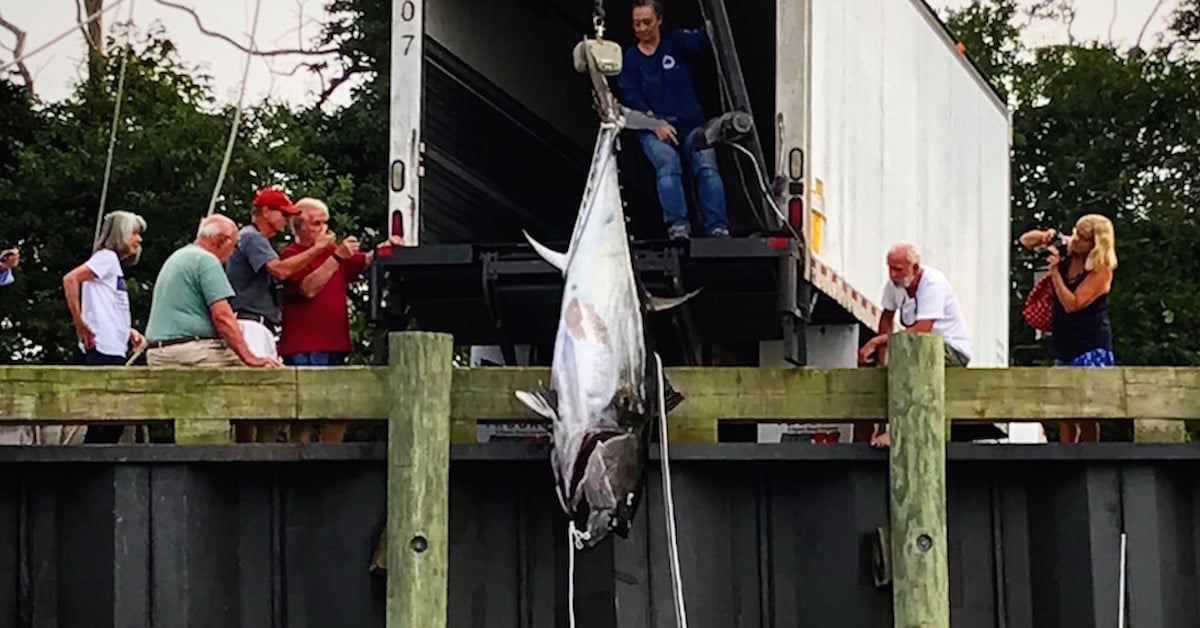
Fishing for bluefin tuna requires a highly migratory species permit which can be purchased here. In addition, fishing for giant tuna requires that the vessel is outfitting with special safety equipment including survival suits, an EPIRB and a life raft.
For most folks it makes more economic sense to target smaller bluefins.
An angling/recreational permit purchased from NOAA will allow an angler to retain bluefin tuna for their own consumption, but no selling of the fish is allowed. No life rafts, survival suits or EPIRBS are required for recreational tuna fishing.
Catching Tuna with Spinning Gear
Spinning gear is one of the most popular means for catching recreational size bluefin tuna. There exists a multitude of spinning setups that will get the job done. The key is finding a setup that is in your price range.
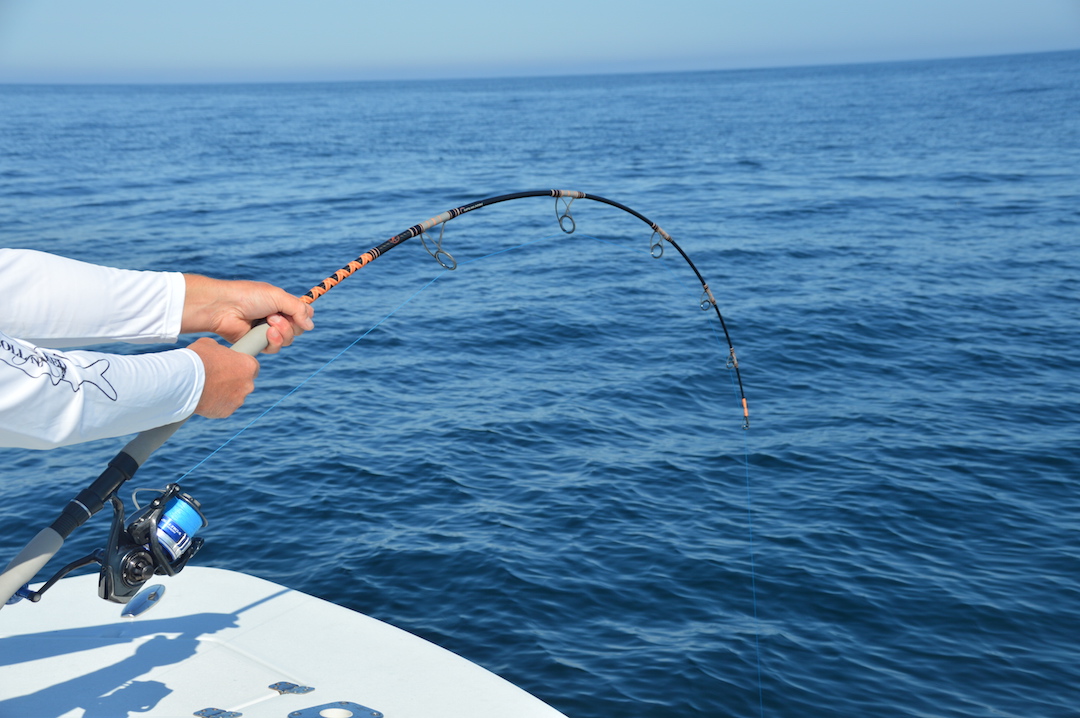
Pictured here is a Daiwa Saltiga 6500H spinning reel and a Crafty One Customs spinning rod. We fought this tuna for over 5 hours before the hooks popped about 25 feet from the boat. The tuna might of been as large as 500 pounds. I never want to hook a tuna that large again on spinning gear!
When I was just getting started tuna fishing on Cape Cod, the Fin-Nor OFS-95 Offshore spinning reel with a full spool of 60# braid paired with a 50# class Fin-Nor Offshore rod was a solid choice at around $300. $300 is on the lower end of the tuna fishing price spectrum, however even better deals may be found by the angler who visits yard sales and keeps a keen eye on craigslist.
Having a few buddies who are obsessed with catching tuna can really help an angler who is just starting out. A single spinning setup will work great when casting to a pod of surface slashing bluefin tuna; however one setup will not create much of a trolling spread, which can really hinder the chances of a hookup when the fish are not showing on the surface.
On the other hand, it will be easy to create a productive trolling spread if each crew member has a spinning setup of their own. Most serious tuna boats choose to troll with expensive conventional reels and pricey squid bars. However for the angler just starting out, spinning setups are the most economical choice.
A boat full of spinning rods will allow each crew member to get in on surface action and will also allow the boat to implement a productive trolling spread. It is like getting the best of both worlds, at a reasonable cost, for anglers just getting into the tuna game.
How We Caught Our First Tunas
Creating a productive trolling spread from a small boat can be done by thinking creatively. Instead of focusing on everything your boat does not have (outriggers, a dozen rod holders, squid bars etc.) focus on what you do have (two to four rod holders, a tackle box with maybe a few large soft plastics and a couple deep diving swimmers).
By utilizing a couple nine inch Slug-Go’s or 14 inch Hogy soft plastics, and two deep diving swimmers, a small boat can troll four different lures at two different depths.
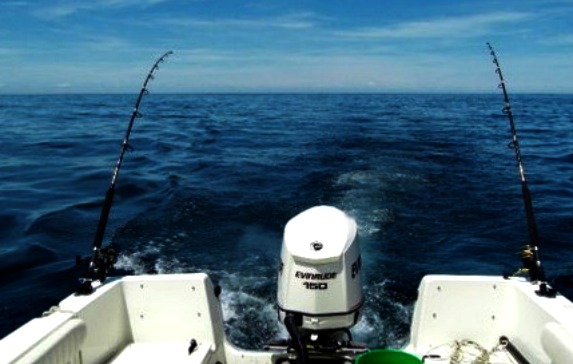
This was our "trolling spread" when we were just starting out. It was an economical choice for us because the spinning gear can be used for casting, jigging as well as trolling.
Set the two deep diving swimmers 30-40 yards off the stern of the boat and place these two spinning rods in the starboard rear and port rear rod holders. Then set the soft plastics 50 yards behind the stern of the boat and place each of these spinning rods in the starboard and port gunnel rod holders.
Successfully done the soft plastics will fish the top of the water column, while the deep divers fish below. The trolling spread will efficiently cover two different spectrums of the water column-not bad for a boat more apt to fishing for stripers and blues.
Catching a tuna from any size boat is an incredible experience. However there is something special about plucking a big fish from the sea while fishing in a not so big boat.
My First Experience Catching a Giant Bluefin Tuna on Cape Cod
There was a slight chop developing on the ocean’s surface as I eased my boat the Miss Loretta into a slow drift on Stellwagen Bank’s legendary southwest corner.
The previous day we had caught eight juvenile bluefish while fishing in Buzzards Bay, and we were eager to send one of the hapless critters flying under the kite. I could not help but feel bad for the little blues, who 12 hours ago were top predators, feeding on silversides in 70 degree bath water.
Now, 40 miles removed from his warm and safe abode, we set our first bluefish under the kite off the port side. The breath of easterly wind was becoming more of a consistent breeze, so I decided to get my mind off the deteriorating conditions by setting another bluefish off the starboard side of the boat. I wondered how much of a weather window we would have before the breeze would send us home.
15 minutes later something strange happened. A gaping hole opened underneath the kite bait and the small bluefish disappeared.
“What just happened!” yelled Todd, our newest crew member.
A second later the ocean erupted in a white water explosion and the unfortunate bluefish was sucked into the gullet of a large bluefin. I looked to the sky and watched the 220 pound mono top shot release from the kite clip. A second later the line came tight and shot off to the west. The drag on the Penn 80 was screaming!
We scrambled around the boat, clearing lines and kicking over buckets, until we finally were able to secure the rod in the port side swivel rod holder. It was pure pandemonium on deck.
My long time fishing buddy, Jason Mazzola, was concerned that the initial drag blistering run would spool us, so I started the engine. I laughed a bit observing the scene, turned the bow to the west, and began following the fish.
Two and one half hours later we had the behemoth just yards beneath the boat’s hull. It was now or never as sea conditions were steadily deteriorating. The tuna swam in a powerful death circle, which made gaining each foot of line agonizingly difficult. Finally she surfaced 15 feet off the port side.
“Throw the poon!” we yelled to Todd. Rearing back he launched a Hail Mary shot at the fish and missed by about five feet. Strike one!
“Stick him!” we yelled. On his second swing Todd sank the dart just behind the 700 pound tuna’s massive head. He eased the fish in towards the port side while Mazzola manned the rod and I readied the gaff and tail rope. My hands were shaking as I sunk the gaff into the fish and secured the rope.
“We got him!” I said turning to the crew. “And guess what? The hook just popped out!”"

Tuna Fishing During June
Nothing beats Cape Cod tuna fishing. Without a doubt, our sandy spit of land is a top destination for world class big game fishing. June is an exciting month to be on Cape Cod Bay and Stellwagen Bank. The whale activity off Provincetown is remarkable, not to mention the enormous schools of striped bass that invade the area.
Switching tactics and pursuing stripers is always a viable alternative if the tuna bite slows. Often time’s 20-40 pound bass are caught on the same pogies and squid bars meant for tuna. If the weather cooperates, June has the potential to be one of the most productive months for anyone wetting a line in the Sound, on the Bay, or at Stellwagen.
The opportunities are truly endless.
The sheer amount of tuna in Massachusetts Bay over the past few seasons has been staggering. Large schools of smaller school size tuna, along with some true giants, have been frequent visitors to the waters off Cape Cod, presenting an incredible opportunity for anyone willing to put in the time and effort.
There has been a lot of hype in the media about bluefin tuna being depleted and on the verge of extinction. This may be true in places like the Mediterranean Sea and off Asia, however our Cape Cod fishery seems strong and the tuna are plentiful.
Live Bait vs. Artificial
For those interested in live baiting a big bluefin, using “snack” size bluefish as bait may be the ticket. Juvenile bluefish should be plentiful in Nantucket Sound, Vineyard Sound and Buzzards Bay this June. The tricky part is figuring out a way to transport the feisty chompers to Cape Cod Bay and Stellwagen Bank.
Pogies may be a more realistic bait source for many. These filter feeders can be gillnetted or cast netted in many of the Cape’s back bays and estuaries. Expect to put in many hours of searching and trial and error before locating and perfecting the art of catching live menhaden.
Artificial baits will still produce plenty of tuna for anglers who would rather not deal with the complexities of obtaining live bait. Squid bars are always popular with captains who like to troll. The jigging and popping crowd always amazes the general population by wrangling tuna on relatively light spinning gear.
There is no wrong way to tackle a tuna-the key is discovering what works best for your crew.
Cape Cod Tuna Fishing Spots

The Cape Cod tuna fishing season gets into swing in June. Each June is completely different, so who knows what's in store for this season. I'll cover my bases by saying it could be great, mediocre or not so great. Tuna can be pretty unpredictable, but odds are that there will be at least some fish relatively close to shore roughly 2.5 months from now.
Early in the season, we have primarily focused our efforts on the SE corner of Stellwagen Bank and around Provincetown. There is usually a lot of life in this area, especially during June. Large sand eels, sea herring and mackerel are often present. Often times you'll find large schools of striped bass feeding in the same spots your are fishing for tuna.
This is especially true around the arm of Cape Cod, in particularly east of Chatham. I always hear stories of folks hooking striped bass on one cast, and a tuna on the next, in this general area. Supposedly it's not uncommon to find bluefins in 40-70 feet of water off Chatham, however I have never seen it with my own eyes. Maybe this will be the year that changes.
Another animal you will likely run into are whales. Humpback whales and pilot whales in particular are regularly seen around Stellwagen and Provincetown.
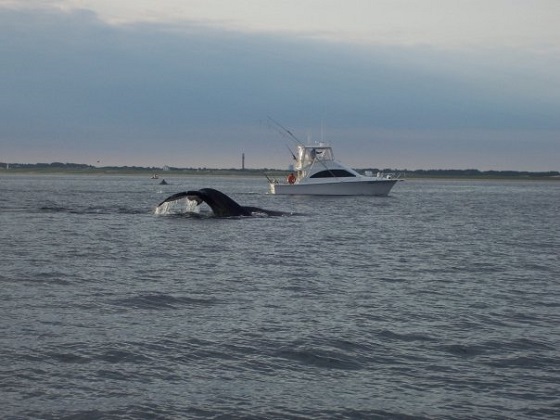
I would recommend trying to keep your distance from the whales if possible. For the small boat angler, whales can pose a significant threat. I can only imagine the damage a breaching whale could cause to a 21 foot boat. Hopefully I will never find out first hand. Nevertheless if you spend enough time in this area, a whale will creep up on you. Keep your eyes peeled and you will be OK.
Gannets and other sea birds are abound and can help you find a patch of water with life. If you have radar, you can use it to zone in on the flocks. Another option is binoculars. Whatever you do, make sure to bring polarized sunglasses. On flat calm sunny days a good pair of sunglasses is a real life-saver.
June is a great time to target bluefins from a small boat because the seas are generally calm and there's a lot of life around. Yet I think September through early November will provide you with the best opportunity of finding close to shore tunas. It seems like the fish become more adventurous as the season comes to a close.
Small and giant tuna roam deep inside Cape Cod Bay starting in mid September. The entire stretch of water from Ellisville in Plymouth, to Billingsgate Shoal off Wellfleet can hold fish. One of the largest tunas I have ever seen breached off our bow while we were fishing in 75 feet of water during late October off Barnstable. There are also many stories of guys in this area hooking (and sometimes landing) small bluefin tuna while trolling bunker spoons for bass.
A few years ago when the half beaks were in thick off Plymouth, the action 5-10 miles outside Plymouth Harbor was impressive. You could see tuna on the horizon propelling themselves into the air chasing the half beaks. We quickly learned that running and gunning after these fish can put a pounding on the crew and the boat. I had a throttle cable snap on me during one trip here, which left us dead in the water - and just out of reach of a school of busting bluefins.
Tuna Fishing Techniques
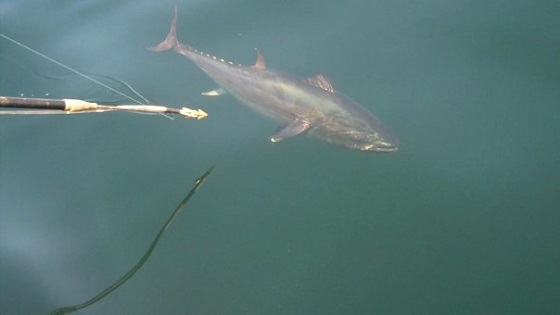
Tuna fishing Cape Cod from a sportfisher is much different than targeting tuna in a 20 something foot walk around or center console. If you are like me, you also don't have thousands of dollars to dump on equipment. Our best and most economical success came by targeting smaller tunas on spinning gear.
Hands down there is nothing cooler than watching a bluefin explode on a popper. It's like top water striped bass fishing multiplied by one thousand. The only issue is that tuna routinely travel at 30 miles per hour, with bursts of speed much higher. Getting within casting range of the fish is oftentimes downright maddening.
Another option is to troll Slug-Go's, Hogys and other soft plastic baits. We have had good success setting soft plastics 50-75 yards behind the boat and trolling between 5 and 6 mph. Try to keep the soft plastics skipping nicely on the surface. If you log in enough hours a tuna will eventually come roaring to the surface, suck down the soft plastic and begin ripping line from your spinning reel.
We've used the Fin-Nor Offshore 9500 series spinning reel and Penn 950s on tuna between 50 and 160 pounds. At least 50 pound braided line is a must. Fluorocarbon leaders help as well. Be sure that the rod you choose has a good amount of backbone, or you'll end up fighting a tuna for 5 hours, which has happened to me.
I think the main key to success in the tuna game is to continue fishing well after you feel like you want to quit. Unless you really luck out, you are going to have to spend a lot of time on the water before you hook (or even see) a tuna fish. This is especially true if you are going to be focusing your efforts on close to shore areas. Nevertheless if you put your time in, you will be rewarded...eventually.
In Conclusion

The tuna above was the first tuna my family landed since my Uncle Gip caught an 878 pound monster during the 70's. I know I will never forget the first bluefin I ever caught. Neither will my Dad, Mazzola or his Dad (all pictured above). I am very glad all four of us were on the boat that day. It's given us something to talk and reminisce about over the years.
If you are yet to catch a tuna, then I urge you to consider giving it a solid and safe effort. The tuna's power is unmatched by any other fish present off Cape Cod. It is exactly like hooking up to a small pickup truck.
How was your first experience catching a tuna? I'd love to hear about it in a comment below.
Tight lines!




The most fun fishing I ever did was back in the mid 80’s,coming out of Nantucket,steaming to the west’ard down to the fingers to handline for the big bluefins. Result 5 fish dressing out 490-520 for 6 days fishing. Big bluefins are fast and powerful. Have a great season John R
Hi John,
That sounds incredible. I can only imagine how challenging it must be to hand line a giant. Especially 5 of them in less than one week!
I hope you have a great season as well, take care.
I love just being in that beautiful environment. Seeing tuna is one of the most amazing wonders of nature. Sixty years living near the ocean, and enjoying all that it offers while respecting the power and hazards of the sea. Salt and sand in my shoes, and the members of this blog too.Have a great season.
Hey Dad,
Yep I’m 100% on board with you there. We will be back out there very soon.
Just a couple more weeks.
I’m such a fan of these pictures! Can’t wait to get back to the Cape for the summer. Fingers crossed we have a few more tuna visitors this season!
Thank you! Hopefully we’ll get some more nice tuna photos this season. I’ll be crossing my fingers too.
Gosh That Made me hungry for sushi .
Tell me about it!
Hey Ryan, Great info,hope to get a chance to hook one. Butch
Hi Butch,
I hope you get the chance to hook one too. It’s quite the experience and can be quite the workout too.
I hope all is well,
Ryan
I never heard of such insane tuna action. A hundred feet or less under the boat? Mind blowing.
In the late eighties I mated on a sport fisherman out of Montauk, where a run to the canyon was the norm.granted the blue fin fishery was in bad shape back then but we never saw anything like that. We probably should have run to the northeast instead. In fact the tuna bite was so bad at the time that the captain lost his shirt and brought the boat back to n.j.
I was the only one who did o.k. Being on salary and tips. Enjoy it while it lasts and yeah give those whales a wide berth. Safe fishing – art Boyd.
Hi Art,
It doesn’t happen often, but it can certainly be insane at times like you mentioned. You must have experienced some incredible trips when making those long runs to the canyons. That sounds incredible to say the least.
I will certainly give those whales as wide a berth as possible.
Have a nice Easter,
Ryan
Hey Ryan
My son Justin got me hooked (no pun intended) amount 2 years ago when he came in with a 150lb bft he had caught out at the canyons. What a beautiful fish. So I rigged my boat and bought the proper gear and tackle and set out into Cape Caod Bay. First year 5 trips no hook-ups. I guess that’s what is ment by “Paying Your Dues”.
Second year (last year) 6 trips, 5 fish. That year I caught 2 fish one was 55″ and the other, well let me tell ya about this one. In late October, after leaving out of Pamnet River at 4 AM, my 2 buddies and I fish all day covering alot of water from Peaked Hill to East of Chatham to the SE tip of Stellwagon back to PH, with nothing to show for our efforts. We were heading from PH and decided to leave our spread out and troll in. Not paying any attenion to the spead, then all of a sudden the reel starts to scream. We were about half way between Race Point and Pamnet, 100 yards of the shore. Landed a nice 69″ 205 lb bft. Yes this magnificent fish do come close to shore and your right any given time or place it can happen.
Whishing you and yours tight lines!!
Dave
Dave
Hi Dave,
You are a perfect example of paying your dues. 6 trips during 2012 with 5 total fish is a spectacular ratio – congrats on that!
Man you guys certainly did cover a lot of water that trip this past October. Pamet to Chatham, to Stellwagen and back….that’s a lot of searching.
Pretty incredible that after all that, you hook up and land a tuna 100 yards off the beach. Unpredictable is the tip of the iceberg with these fish.
Thanks for chiming in and take care.
Hey Ryan,
You looked all wet in one of those photos. Did you have to jump in to land the tuna?
P.S. Great shot of the whales near the beach!
Hi Steve,
I had just gone for a victory swim after landing that fish. We had 2 folks on board that day who had never seen a tuna, so it was pretty exciting – and about 90 degrees.
I don’t think I’ll be jumping in anymore with all the sharks around!
The day we took that photo of the whales was incredible. There must have been 50 or more humpbacks right off Provincetown that day. Really spectacular sight to say the least….no tuna around them though oddly enough.
Ryan
Our homeport is MONTAUK however keep boat in Harwich at Saquatucket.
late summer. Email me as I would like to discuss Plymouth…I believe we will be up there late summer this season.
Vito
Hi Vito,
Sounds good. I’ll shoot you an email now.